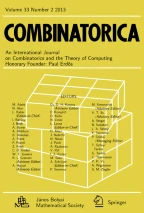Abstract
Given a matroidM with distinguished elemente, aport oracie with respect toe reports whether or not a given subset contains a circuit that containse. The first main result of this paper is an algorithm for computing ane-based ear decomposition (that is, an ear decomposition every circuit of which contains elemente) of a matroid using only a polynomial number of elementary operations and port oracle calls. In the case thatM is binary, the incidence vectors of the circuits in the ear decomposition form a matrix representation forM. Thus, this algorithm solves a problem in computational learning theory; it learns the class ofbinary matroid port (BMP) functions with membership queries in polynomial time. In this context, the algorithm generalizes results of Angluin, Hellerstein, and Karpinski [1], and Raghavan and Schach [17], who showed that certain subclasses of the BMP functions are learnable in polynomial time using membership queries. The second main result of this paper is an algorithm for testing independence of a given input set of the matroidM. This algorithm, which uses the ear decomposition algorithm as a subroutine, uses only a polynomial number of elementary operations and port oracle calls. The algorithm proves a constructive version of an early theorem of Lehman [13], which states that the port of a connected matroid uniquely determines the matroid.
Similar content being viewed by others
References
D. Angluin, L. Hellerstein, andM. Karpinski: Learning read-once formulas with queries,J. of the Association for Computing Machinery 40 (1993) 185–210.
N. Bshouty, T. Hancock, L. Hellerstein, andM. Karpinski: An algorithm to learn read-once threshold formulas, and transformations between learning models,Computational Complexity 4 (1994) 37–61.
R. E. Bixby: Matroids and operations research. in:Advanced Techniques in the Practice of Operations Research, (H. J. Greenberg, F. H. Murphy, and S. H. Shaw, eds.), North-Holland Publishers (1980) 333–459.
R. E. Bixby, andW. H. Cunningham: Converting linear programs to network problems,Mathematics of Operations Research 5 (1980) 321–357.
R. E. Bixby, andD. K. Wagner: An almost linear time algorithm for graph realization,Mathematics of Operations Research 13 (1988) 99–123.
T. H. Brylawski, andD. Lucas: Uniquely representable combinatorial geometries,Teorie Combinatorie (Proc. 1973 Internat. Colloq.) 83–104, Accademia nazionale dei Lincei, Rome, (1976).
D. Hausmann, andB. Korte: The relative strength of oracles for independence systems, in:Special Topics of Applied Mathematics, (J. Frehse, D. Pallaschke, and U Trottenberg, eds.), North-Holland Publishers (1980) 195–211.
L. Hellerstein, andC. Coullard: Learning binary matroid ports,Proceedings of the 5th Annual SIAM Symposium on Discrete Algorithms (1994) 328–335.
P. M. Jensen andB. Korte: Complexity of matroid property algorithms,SIAM Journal of Computation,11 (1) (1982) 184–190.
J. Kahn: On the uniqueness of matroid representations over GF(4).Bull. London Math Soc. 20 (1988) 5–10.
M. Kearns, M. Li, L. Pitt, andL. Valiant: On the learnability of boolean formulae,Proc. 19th ACM Symposium on Theory of Computing (1987) 285–295.
M. Kearns, andL. Valiant: Cryptographic limitations on learning boolean formulae and finite automata,Proc. 21st ACM Symposium on Theory of Computing (1989) 433–444.
A. Lehman: A solution of the Shannon switching game,Journal of the Society of Industrial and Applied Mathematics 12:4 (1964) 687–725.
J. G. Oxley:Matroid Theory, Oxford University Press, New York, (1992).
J. G. Oxley, D. Vertigan, andG. Whittle: On inequivalent representations of matroids over finite fields, Technical Report, Department of Mathematics, Louisiana State University, Baton Rouge, LA 70803, (1994).
L. Pitt, andL. Valiant: Computational limitations on learning from examples,J. ACM 35 (1988) 965–984.
V. Raghavan, andS. Schach: Learning switch configurations,Proceedings of Third Annual Workshop on Computational Learning Theory Morgan Kaufmann Publishers (1990) 38–51.
V. Raghavan, andD. Wilkins: Learning μ-branching programs with queries,Proceedings of the Sixth Annual Workshop on Computational Learning Theory, ACM Press (1993) 27–36.
P. D. Seymour: The forbidden minors of binary clutters,J. London Math. Soc. (2)12 (1975) 356–360.
P. D. Seymour: A note on the production of matroid minors,J. of Combinatorial Theory (B) 22 (1977) 289–295.
P. D. Seymour: The matroids with the max-flow min-cut property,J. of Combinatorial Theory (B) 23 (1977) 189–222.
P. D. Seymour: Recognizing graphic matroids,Combinatorica 1 (1981) 75–78.
K. Truemper:Matroid Decomposition, Academic Press, San Diego, (1992).
W. T. Tutte: An algorithm for determining whether a given binary matroid is graphic,Proc. Amer. Math. Soc. 11 (1960) 905–917.
D. J. A. Welsh:Matroid Theory, Academic Press, London, (1976).
Author information
Authors and Affiliations
Additional information
Research partially funded by NSF PYI Grant No. DDM-91-96083.
Research partially funded by NSF Grant No CCR-92-10957.
Rights and permissions
About this article
Cite this article
Coullard, C.R., Hellerstein, L. Independence and port oracles for matroids, with an application to computational learning theory. Combinatorica 16, 189–208 (1996). https://doi.org/10.1007/BF01844845
Received:
Issue Date:
DOI: https://doi.org/10.1007/BF01844845
